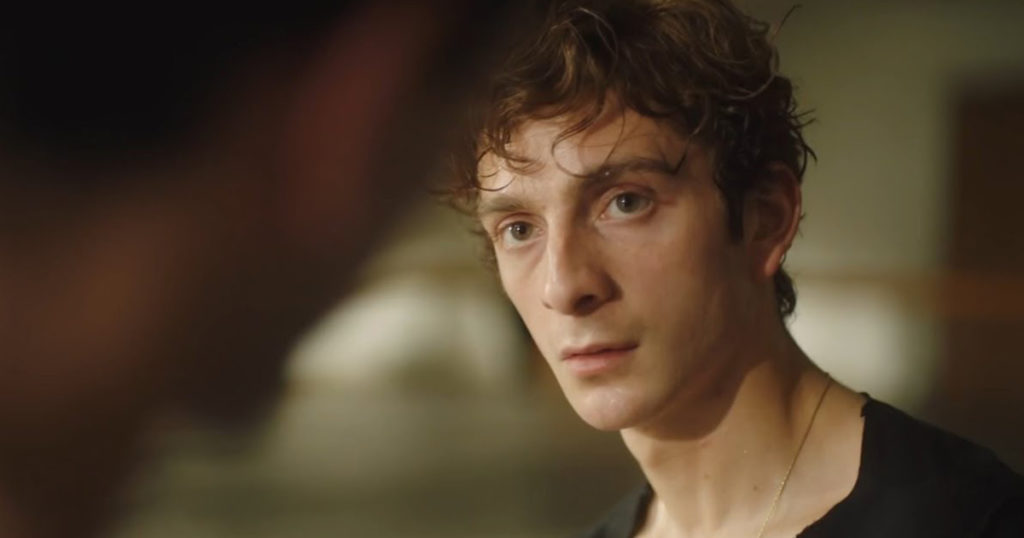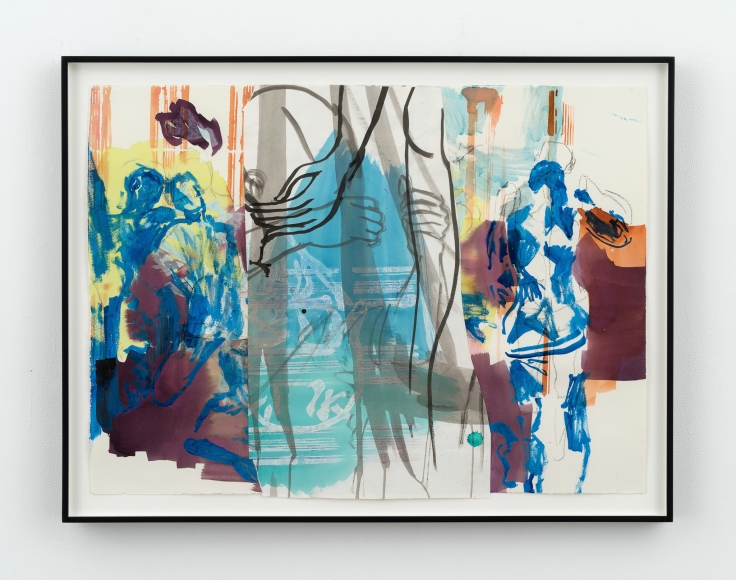Céline Sciamma’s Portrait of a Lady on Fire captured critics’ hearts, and seemed a sure shot to capture mine. An acclaimed French lesbian film? Made for me! And yet, though I did like looking at Adèle Haenel’s incongruously contemporary face in period garb, the overblown, gestural romance left me un-aflame. “Do all lovers feel that they’re inventing something?” Heloise asks Marianne before they first sleep together, and I wished that something more precise, more personal, were being invented. I found that specificity in a different international gay film, And Then We Danced, which follows a delicate-boned dancer as he tries to keep his hands from fluttering during traditional Georgian dance, his only path out of a country where he cannot survive. Shot in four weeks on a minuscule budget, the film received a standing ovation at Cannes. In Georgia, it was met with such violent far-right protests that it closed after three screenings, but a queer Georgian youth movement has mobilized around the film, and its soundtrack, as a beacon of hope. The movie’s portrayal of first love made me bite my lip, but even more vivid were the moments of tenderness between two brothers, between grandparents and grandchildren, and the spaces the camera inhabits in Tbilisi, from nightclubs to cramped apartments to ballrooms. It’s a love letter to Georgia that asks simply: Love me back. —Nadja Spiegelman
I spent much of December working with Nathaniel Mackey and Cathy Park Hong on Mackey’s Art of Poetry interview, which is in our new issue (online now, on newsstands Tuesday). In working on the manuscript across winter’s darkest days I had a sensation not unlike that accompanying opening up an Advent calendar. Behind one paper door was the poetry of Henri Coulette, behind another was John Coltrane—both of which were familiar to me, as Michael S. Harper made Coulette required reading for his undergraduate seminars, and Coltrane, well, I was carrying a coffin-size saxophone case around Seattle at age twelve, of course I know my Trane. But other doors opened to new-to-me delights—Mackey’s epistolary novels, which are but a grace note in this Art of Poetry interview, revealed a rabbit hole, and I eagerly devoured N’s letters in Late Arcade. The epic poem Paterson wasn’t new to me, but after reading Mackey’s description of its landscaping, I’ll never look at William Carlos Williams the same way again. Behind another door was Cathy’s new essay collection, Minor Feelings, which I started one Friday night and didn’t look up from again until it was done on Saturday evening. It’s a tremendous book of essays, inquisitive and honest and necessary. It seems I’ve just picked four books and a record, which is to say I’m actually pointing to a style of creative exploration that Mackey has internalized and deployed to great effect across his storied career. One part explorer, one part magpie, he weaves his work from many threads, and that curiosity is catching. As for me, I’m keeping those doors open all year. —Emily Nemens
In the hellscape of Instagram lies a savior, Sam Youkilis. In a simplistic way, Youkilis could be described as a travel photographer, but that moniker does no justice to breadth of his work. Yes, he’s more often than not in a beautiful place, eating gorgeous food and drinking perfect wine, but he is also capturing the soul of the landscape and the people who inhabit it. A great deal of his work is showcased in the Stories feature of Instagram, where he posts moving (in both senses of the word) portraits, often in curated series. Recently he has been posting videos from Chefchaouen, a city in Morocco known for its buildings in varying shades of blue. When you click on the geotag for Chefchaouen, a grid appears, dappled with travel influencers posing cross-legged on blue steps. In stark contrast, one of Youkilis’s posts features two little boys arm in arm running down a cerulean alleyway. Often it feels like Instagram’s sole purpose is to elicit envy, and yet I, someone prone to jealousy, never feel spiteful looking through Youkilis’s posts. His ability to capture the purest moments of everyday life assures me that if anyone deserves to be somewhere exciting and new—it’s @samyoukilis. —Eleonore Condo
There are no huge surprises on this new album from jazz legend Charles Lloyd, 8: Kindred Spirits, Live from the Lobero—it sounds a lot like Lloyd’s recent live albums—except the usual surprises that come with excellent, sinuous improvisation, and the presence of once-rising, now-risen star Julian Lage on a guitar that is alternately icily cutting and warmly resonant, and the organist Booker T., who quietly adds dimensions. Lloyd is one of the last active musicians from his great mid-’60s generation, and his round tone on sax and distinctive phrasing, which alternates between long, slow notes and sudden crunched runs, is recognizable from a mile away. His music moves effortlessly between a kind of hip profundity and a funky strut. He’s backed here by longtime bandmates, including Eric Harland, one of the best drummers alive, and pianist Gerald Clayton, who comes to the forefront of this music. There’s also a very expensive limited-release deluxe edition that includes an additional hour of music that is as wonderful as the rest, except for a rather ham-fisted vocal number called “A Song for Charles” (“Charles is a gift to the world/to me and you …”), which most listeners will want to skip over. No huge surprises, but, actually, lots of little ones, particularly in the twenty-minute version of Lloyd’s warhorse “Dreamweaver,” which opens the album. —Craig Morgan Teicher
Nick Mauss, though a visual artist by trade, is a scrupulous scholar of modernist dance. With each new work, he tests the limits of his form, capturing, in paint, the ephemeral nature of bodies in motion. Mauss is no stranger to Chelsea, having made a home at both the Whitney and 303 Gallery, where his latest solo show is on view through April 11. In a new collection of sketches and paintings, as in his other work, Mauss pays homage to the mid-century aesthetic. His architectural compositions recall the neoclassicism of Balanchine and Stravinsky. And his tender representations of the male body evoke the poetry and portraiture of Frank O’Hara and Fairfield Porter, respectively. Upon entering through a painted door, the viewer is immediately disarmed by a sketch of nearly life-size nudes in foreshortened perspective. These figures, rendered in ink on enamel paper, appear unfinished. Like others in the gallery, the work seems as if it has been torn from an oversize sketchbook. Neighboring pieces are even stained with coffee and ring-shaped marks where cups of paint once rested. The art, seemingly a record of Mauss’s own dynamic process, brings to mind dance notation. I left the gallery imagining the artist at work, in motion, as much a dancer as he is a choreographer. —Elinor Hitt
My memory has always been bad, though the past two years or so it’s been dreadful. Sufficiently poor that, when I’m tired, it seems that the blanks extend to the most common of words. If severe, the forgetting of words is called anomic aphasia. Or so my doctor told me when—quite blithely—she dismissed my concerns out of hand. (“No, you don’t have it. Get some sleep.”) Others have different names for the condition: in my conversations with the Review’s digital director, he has referred to it as “middle age.” Regardless of the nomenclature, the rewards of the condition are few, and the frustrations are many. But my obsession did recently draw me to a collection of interviews with, and essays on, W. G. Sebald, titled The Emergence of Memory and edited by Lynne Sharon Schwartz, a highlight of which is Sebald’s interview with Michael Silverblatt. I had first listened to this episode of Bookworm one evening, years ago, in a small kitchen in Paris while I cooked dinner, my laptop perched precariously on top of the fridge, and the conversation between these two respectful, calmly erudite men stayed with me. Early on, Silverblatt describes the manifestation of the Holocaust in the elegiac Austerlitz as a “silent presence being left out but always gestured toward.” To this Sebald responds: “Your description corresponds very much to my intentions.” It is an inconsequential reply, I suppose, but something about it seemed so simple, so accurate, and so very full of him. I remember how formal Sebald seemed, almost weary, though still friendly and engaged. I remember, too, his tones as he spoke that phrase, and have often repeated it to myself over the years, though I don’t precisely know why. It was reassuring to see the sentence reproduced on the page. And not only because I had remembered it correctly. —Robin Jones
from The Paris Review https://ift.tt/39uGVPd



Comments
Post a Comment